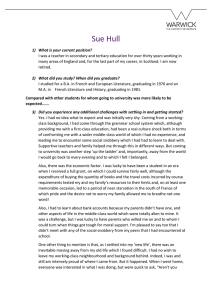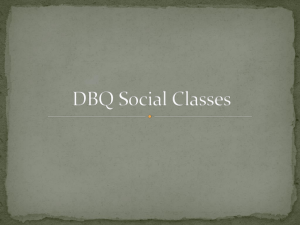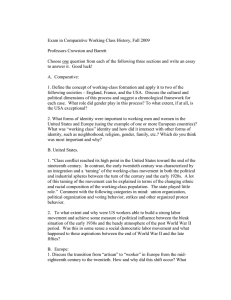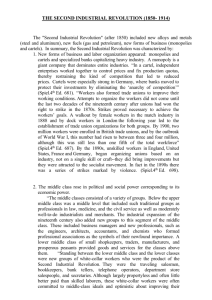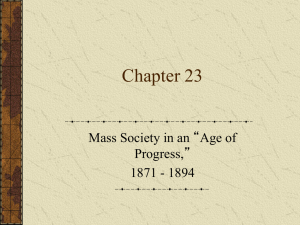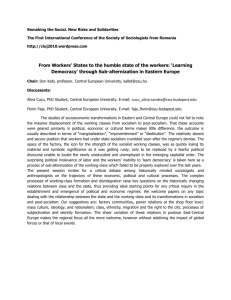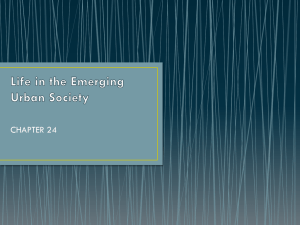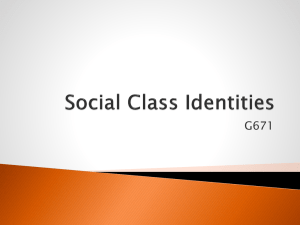A common culture? Lecture notes Class
advertisement
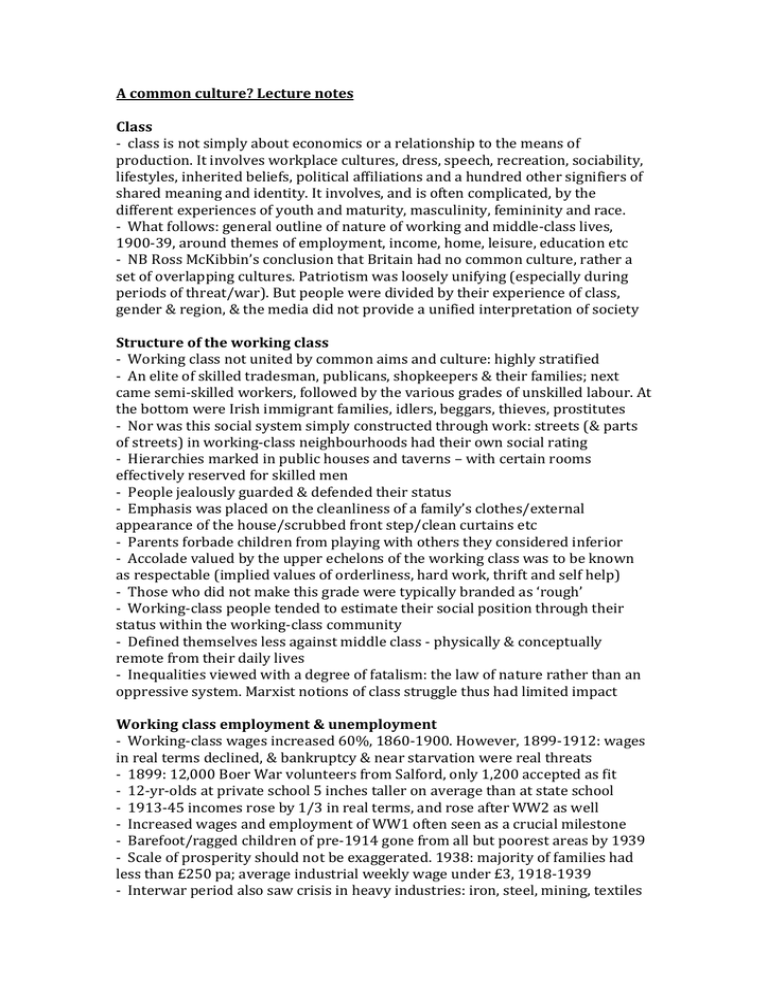
A common culture? Lecture notes Class - class is not simply about economics or a relationship to the means of production. It involves workplace cultures, dress, speech, recreation, sociability, lifestyles, inherited beliefs, political affiliations and a hundred other signifiers of shared meaning and identity. It involves, and is often complicated, by the different experiences of youth and maturity, masculinity, femininity and race. - What follows: general outline of nature of working and middle-class lives, 1900-39, around themes of employment, income, home, leisure, education etc - NB Ross McKibbin’s conclusion that Britain had no common culture, rather a set of overlapping cultures. Patriotism was loosely unifying (especially during periods of threat/war). But people were divided by their experience of class, gender & region, & the media did not provide a unified interpretation of society Structure of the working class - Working class not united by common aims and culture: highly stratified - An elite of skilled tradesman, publicans, shopkeepers & their families; next came semi-skilled workers, followed by the various grades of unskilled labour. At the bottom were Irish immigrant families, idlers, beggars, thieves, prostitutes - Nor was this social system simply constructed through work: streets (& parts of streets) in working-class neighbourhoods had their own social rating - Hierarchies marked in public houses and taverns – with certain rooms effectively reserved for skilled men - People jealously guarded & defended their status - Emphasis was placed on the cleanliness of a family’s clothes/external appearance of the house/scrubbed front step/clean curtains etc - Parents forbade children from playing with others they considered inferior - Accolade valued by the upper echelons of the working class was to be known as respectable (implied values of orderliness, hard work, thrift and self help) - Those who did not make this grade were typically branded as ‘rough’ - Working-class people tended to estimate their social position through their status within the working-class community - Defined themselves less against middle class - physically & conceptually remote from their daily lives - Inequalities viewed with a degree of fatalism: the law of nature rather than an oppressive system. Marxist notions of class struggle thus had limited impact Working class employment & unemployment - Working-class wages increased 60%, 1860-1900. However, 1899-1912: wages in real terms declined, & bankruptcy & near starvation were real threats - 1899: 12,000 Boer War volunteers from Salford, only 1,200 accepted as fit - 12-yr-olds at private school 5 inches taller on average than at state school - 1913-45 incomes rose by 1/3 in real terms, and rose after WW2 as well - Increased wages and employment of WW1 often seen as a crucial milestone - Barefoot/ragged children of pre-1914 gone from all but poorest areas by 1939 - Scale of prosperity should not be exaggerated. 1938: majority of families had less than £250 pa; average industrial weekly wage under £3, 1918-1939 - Interwar period also saw crisis in heavy industries: iron, steel, mining, textiles - unemployment never below 1 million, 1918-1939; peak of 3 million, 1932-33 - 1936: Jarrow hunger marches; but build-up to WW2 soon cut unemployment - Depression and deprivation existed alongside rising standards elsewhere - Some redistribution of the tax burden in favour of working-class families in this period, but little redistribution of wealth Unions - 1911: 3 million trade union members; 1920: 8.3 million; 1933: 4.4 million - A major power base but union members could be victimised by employers, & union bargaining power was undermined by economic recession and layoffs - Unions also undermined by disunited nature of working-class workforce: fractured along working-class dividing lines of skill, status & hierarchy Gender & the working class - Adult male identity based on work and wage earner status - Male sociability of workplace also translated to another male domain: the pub which was often more the site of male sociability than home - Women were largely in control of the family budget; & mothers & grandmothers also guardians of working-class standards - Though often employed as well, women used the home as a power base Working-class home - 1850: 5% working-class families owned homes; 1939: 20% - 1920: 1 house in 17 had electricity – 1939: 2 in 3 - Programmes of inner city slum clearance initiated particularly during 1930s - Legislation: Addison, Wheatley & Greenwood Housing Acts (1919, 1924, 1930) - As Orwell noted, condition of much older rented housing remained appalling - Families often had furniture made from packing crates, jam jars for cups etc - Accommodation was often very overcrowded, with parents sharing rooms with their children; even in the late 1940s, 2 or 3 children might share a bed Working-class consumption - For those in steady work, the 1920s and 1930s saw an unprecedented rise in consumerism that would further accelerate after WW2 - More spending on non-necessities; new chain stores; wider choice; more advertising aimed at working-class, eg by Kelloggs, Heinz, Birds, Bisto - Hire purchase put costly items (eg furniture) within their reach for first time - Working-class women increasingly used face cream, powder, rouge - Working-class men increasingly used mass tailoring companies like Burton’s - Greater spending also possible because they were having fewer children Working-class recreation - More spending power also meant more opportunities for recreation/leisure - Many families began to take annual holidays to seaside destinations: Blackpool - Golden era of cinema: cheap tickets, plush seats, luxurious & exotic décor - The new, post-WW1 working-class melting pot of the dance hall - Other leisure items came within working-class means: eg radio - Period thus saw growth of a more unified working-class mass cult - To some extent, radios, gramophones etc drew this entertainment indoors, with home becoming more of a focus of male leisure than before Working-class education - 1880: compulsory schooling began. Most children left school at 12, until raised to 14 by 1918 Education Act. 1912: 4/5 children did not attend secondary school - 1920s: elementary school remained the whole education for 75% of children - Secondary education: for fee-paying & scholarship pupils, & often dominated by the middle class (1944 Butler Education Act abolished these fees, & the school leaving age was also raised to 15 after WW2) - Working-class parents often knew little about education system. Sceptical of its value, prizing practical on-the-job training. Expected children to contribute to family finances, which often ruled out secondary education altogether - Those who did stay on at school risked being estranged from family and friends who might mock them for putting on airs & graces etc Middle class - Broad, diverse grouping: clerks to professionals to wealthy business families - Membership not necessarily a matter of income: clerks & skilled workers could earn much the same. But identifiable through lifestyle, dress, aspiration etc - Middle class grew in size over period & changed in occupational structure; also increasingly culturally homogeneous - Tended to be salaried employees in white-collar jobs not cash wage workers - On average earned and spent twice as much as a working-class family - 1925 - : a long golden age for middle class of low tax & increasing real incomes - Majority of middle class never experienced unemployment at all Middle-class housing - Interwar period: huge increase in middle-class home ownership; homes defined against & separate from working-class industrial urbanisation - Though often closely packed, middle class thirsted for privacy and individuality - Availability of servants declining, but still 500,000 households with 1 or more servants in residence in 1931 - Through domestic servants, therefore, such people could exercise a relationship of personal superiority over the working classes Middle-class spending & consumption - Middle class spent far more on things like insurance, pensions & savings - Interwar period also saw a sharp rise in middle-class consumption - Spent twice as much as working class on clothing: vital for social status - Could afford an increasing range of electrical and other durable goods - Cars became much cheaper (but still beyond working-class incomes) - Prosperity was also heightened by decreasing family size Middle-class recreation - Middle-class recreation far more centred on home than for working class: drinks and dinner parties etc - Middle-class sociability was thus more the joint realm of men and women - Outside home, middle-class entertainment excluded and avoided the masses - Middle-class emphasis on members-only associations; golf/tennis clubs etc - Unlike working-class sociability & recreation, middle-class events were unspontaneous & scripted, with complex social formalities and etiquettes Middle-class self-image - Interwar period: middle class increasingly defined itself as the constitutional class, the defender and repository of the public good & national values - Also, with great unanimity, defined its interests through the Conservative Party, seen as the defender of the constitution, the nation & the public - Through these beliefs & assumptions, middle-class people tended to define the national interest in terms of their own interests (see McKibbin) - Formed a broad middle-class anti-socialist coalition during the 1920s and 30s - Nonetheless, middle-class defined itself as tolerant, well mannered, easygoing Middle class & upper class - Culturally, the line between the middle & upper classes was blurring - Exclusively upper-class areas of social/economic life were getting narrower - Upper class collapsing into upper middle class, no longer the arbiter of fashion - Norms increasingly defined by middle class at public school, universities etc Middle-class education - widening of middle-class opportunity & dominance during this period - Secondary education dominated by middle class - Children of less wealthy families went to grammar schools; wealthier educated privately. The fees were entirely beyond all working-class budgets - Private education conferred status & opportunities: old boys’ network - 1939: 70% of army officers had been to one of the top public schools Hostility to working-class & unions - Middle class began & ended period as anti-working class - These feelings heightened by middle-class anxieties after WW1: fears of bolshevism, and perceived powerlessness over the unions, were joined to a temporary decline in middle-class incomes and a rise in the cost of living - Middle-class men acted as strike breakers during 1920s (drove trams & trains/carried coal/maintained municipal services), increasing middle-class tendency to identify the working-class as a whole with trades unions - Myths grew up of working classes living comfortably on dole: selfish, irresponsible, frivolous and unconcerned with the wider good
